About the Breed!
The Labrador Retriever was originally bred to be a friendly companion and a working dog, making it the perfect pet for anyone who wants a loyal and intelligent four-legged friend. Over time, the Labrador dog breed has become one of the most popular dog breeds in the world, winning the hearts of people from families to royalty and celebrities.
Labradors are large, strong dogs with solid bones and a sturdy build. Their heads are broad, with soft, intelligent-looking eyes that show their friendly and easy-going nature. Their tails, often described as “otter-like,” are strong and always wagging, showing their happiness and excitement. In Pakistan, this popular dog breed is also admired for its playful and loving personality.

Labrador Retriever History:
The Labrador Retriever, often called a “Lab,” is one of the most popular dog breeds in the world. Originally from Britain, this friendly dog was bred from St. John’s water dogs in Newfoundland, Canada. Its name comes from the Labrador region in Canada. Today, Labs are not just popular in Western countries but are also a beloved dog breed in Pakistan for their loyal nature.
Labradors are known for being energetic, playful, and great with families. They were first trained as hunting dogs but are now more commonly kept as pets. Many also work as guide dogs, therapy dogs, or rescue dogs because of their intelligence and gentle behavior.
The breed’s history goes back to the 1830s when British nobles brought St. John’s water dogs to Europe. These dogs were mixed with British hunting dogs to create the Lab we know today. By the 1880s, breeders like the Duke of Buccleuch and Earl of Malmesbury worked together to perfect the Labrador Retriever breed. Their efforts led to the Labs we see now, with traits like short coats, strong legs, and a love for water.
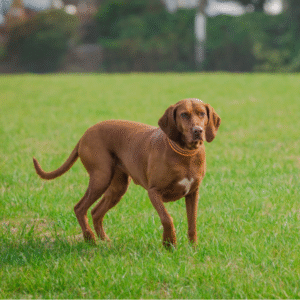
Early Labradors were mostly black, but chocolate and yellow Labs appeared by the late 1800s. The Kennel Club officially recognized the breed in 1903, and it quickly became a favorite worldwide. In Pakistan, this popular dog breed is admired for its adaptability to both city life and outdoor adventures.
Labs are sometimes confused with the larger Newfoundland dog, but they’re smaller and more agile. Their friendly personality and easy-to-train nature make them a top choice for families, hunters, and even service organizations. Whether as a playful pet or a hardworking helper, the Labrador Retriever remains one of the most loved dog breeds across the globe.
Labrador Retriever Health:
Labrador Retrievers are generally healthy dogs, but there are a few health conditions that potential owners should be aware of. Responsible breeders screen for common health problems like hip and elbow dysplasia, heart disorders, and eye conditions, such as progressive retinal atrophy. One condition called exercise-induced collapse (EIC) can affect some young adult Labs, but DNA testing helps breeders identify carriers to avoid passing on the disease. Like other large dogs, Labs are at risk of a serious stomach condition called bloat, so owners should know the signs and what to do in case it happens.
The average lifespan of a Labrador Retriever is between 11 and 13 years. While they are generally healthy, there are a few health issues that may come up during their life.
Ear Infections
Labradors are prone to ear infections because their ears are floppy, which can trap moisture and wax. Swimming can also lead to water getting trapped in their ears, causing infections. Symptoms of an ear infection include redness, head shaking, rubbing ears, and an odor. To reduce the risk, clean your Lab’s ears with a vet-recommended ear cleaner regularly, especially after swimming or bathing.
Tricuspid Valve Dysplasia (TVD)
TVD affects the heart and causes blood to leak backward into the right atrium. This can lead to symptoms like coughing, difficulty breathing, and a rapid heart rate. While surgery may be needed in some cases, many Labradors with TVD can live a normal life with proper care.
Elbow Dysplasia
This condition affects the elbow joint and can cause pain and lameness, especially after exercise. Surgery is usually required to treat it.
Hip Dysplasia
Hip dysplasia is a common condition in Labradors, where the hip joint doesn’t fit correctly, leading to arthritis. Symptoms include lameness, difficulty getting up, and reluctance to run or jump. Treatment options include joint supplements, medication, or surgery depending on the severity.
Centronuclear Myopathy (CNM)
CNM is a rare genetic condition that affects the muscles and can cause weakness, especially in the hind legs. Symptoms typically appear in puppies between 2 and 5 months old. While there is no cure, genetic testing can identify carriers, and reputable breeders test for CNM before breeding.
Exercise-Induced Collapse (EIC)
EIC is an inherited condition where Labradors experience weakness and loss of coordination in their hind legs after exercise or excitement. While episodes usually improve with rest, a dog’s temperature can rise dangerously high during an episode. DNA testing can help identify if a dog carries the gene for EIC.
Hemangiosarcoma
Hemangiosarcoma is a type of cancer that can affect the spleen, liver, or heart. It is a very aggressive cancer that can cause internal bleeding and is often hard to detect in the early stages. Symptoms include weakness, pale gums, and difficulty breathing.
Progressive Retinal Atrophy (PRA)
PRA is an eye condition that leads to gradual blindness. It is usually seen in Labradors between the ages of 3 and 9. While there is no cure for PRA, blind Labradors can live happy lives with support from their owners.
Labrador Retrievers are a popular dog breed in Pakistan, known for their friendly personalities and adaptability. However, it’s important for owners to stay informed about these potential health concerns to provide the best care for their pets.
Labrador Retriever Grooming Guide:
Labrador Retrievers are easy to take care of when it comes to grooming, but they do shed quite a bit. Brushing your dog regularly will help keep the shedding under control.
Skin Care
Labrador Retrievers don’t need special skin care, but it’s important to make sure they are completely dry after swimming or baths to prevent skin infections. If you notice any changes in your dog’s skin, it’s a good idea to check with your vet.
Coat Care
Labrador Retrievers have a thick double coat that helps keep them dry in the water. This coat means they shed a lot, so brushing them two or three times a week will help. Even with regular brushing, though, you might still find loose hair around your house.
Labrador Retriever Nutrition & Feeding Guide:
The Labrador Retriever thrives on high-quality dog food, whether it’s store-bought or homemade, as long as it’s made with your vet’s guidance and approval. The dog’s diet should be suitable for its age, whether it’s a puppy, adult, or senior dog. Some Labradors tend to gain weight easily, so it’s important to monitor their calorie intake and weight. While treats are great for training, giving too many can lead to obesity. It’s essential to know which human foods are safe for dogs and which ones aren’t. If you’re ever concerned about your dog’s diet or weight, consult your vet. Always ensure that fresh, clean water is available to your dog at all times.
Labrador puppies should be fed high-quality puppy food designed for large breeds until they reach one year old. After that, switch to a nutritious adult food made for large breeds to meet their needs.

When choosing dog food, make sure it meets the standards. Some brands, like Royal Canin®, offer Labrador-specific formulas that are scientifically designed to support the breed’s health. Petpawtner offers a wide range of imported high-quality dog food on affordable prices and COD all over Pakistan.
How to Feed a Labrador Retriever
Labrador Retrievers do best with two meals a day—morning and evening. This breed loves food and is known to eat quickly. If your dog tends to gulp down their meals, consider using a slow feeder bowl. This will help control the amount of food they eat at once and prevent issues like vomiting or upset stomachs caused by eating too fast.
How Much to Feed a Labrador Retriever
Labrador puppies go through rapid growth stages, so it’s important to feed them a high-quality puppy formula until they turn 1 year old. Puppy food provides the extra nutrients and calories needed for proper growth. Be sure to follow the feeding instructions on the large-breed puppy food bag, based on the dog’s age and expected weight.
Once your Labrador reaches 1 year old, switch to a high-quality adult food made for large breeds. This type of food contains fewer calories to help prevent unnecessary weight gain.
To determine the right amount of food for your Labrador, always check the feeding guidelines on the dog food package. You can also ask your vet for advice to help maintain a healthy weight for your dog.
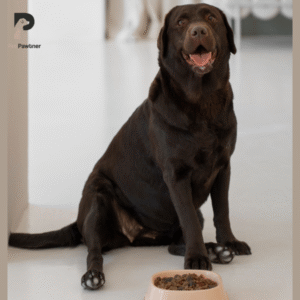
Nutritional Tips for Labrador Retrievers
If your dog is eating food that meets the World set for pet food standards, they should be getting all the essential nutrients they need, and additional supplements are not necessary. However, Labradors with specific health concerns may benefit from certain dog supplements.
Labrador Retriever Training:
Labrador Retrievers are very strong and energetic, so it is important to start to train them at an early age. Between the age of 7 weeks and 4 months old, introduce your Labrador puppy to different people of your surrounding, places, and experiences. Starting obedience training in this particular age will help them grow calm, polite adult dogs. Puppy Dog classes aren’t just about training—they also help socialize your Labradors and teach you how to spot and fix bad habits before they get worse. Labradors are loyal, smart, and love being around people, so make sure they’re included in family life!
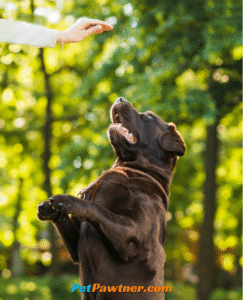
Training a Lab is usually fun because they’re clever, eager to please, and love working with their owner. Even though they’re not usually troublemakers, they still need training. Labs have lots of energy and need jobs to do to keep their minds busy. Without enough exercise or ways to use their natural instincts (like fetching or exploring), they can get too hyper—or even start chewing things they shouldn’t!
Since Labs were bred to retrieve things, use positive, reward-based training. This helps them happily hand over “treasures” they find (like your socks or sticks!).
Changes made:
- Simplified vocabulary (e.g., “biddable” → “eager to please,” “hard-wired breed behaviours” → “natural instincts”).
- Make short forms instead of long sentences, and conversational ones.
- Added relatable examples (chewing socks) and friendly tone.
- Keep the same order of ideas as the original.
FAQ’s
Is a Labrador a good family dog?
Labrador Retrievers are one of the favorite and famous dog breeds in families. They are calm, friendly, and loving nature makes them perfect for big families. Labrador dog breeds are smart, intelligent, easy to train, and they are making their owners happy.
Why are Labrador Retrievers such a great Dog Breed for families?
Here’s why Labrador Retrievers are a favorite, even as a popular dog breed in Pakistan:
Great with Kids: Labrador dogs are calm and patient, even around naughty or noisy children.
Loving and Loyal: They form strong connections with their families and always seek care, cuddles and attention.
Friends with Other Pets: They usually feel comfortable with cats, dogs, and other animals.
Easy to Train: Their intelligence and eagerness to learn make training easy & enjoyable, and are ideal for busy families.
Full of Energy: Labrador Retrievers love playtime, walks, and outdoor fun with owners, making them perfect for active families.
Protective Watchdogs: They are very active in the night as watchdogs, and their loud bark alerts families to strangers, keeping homes safe.
Forever Loyal: Labs stick by their family’s side, offering endless love and companionship.
In Pakistan, the Labrador Retriever is a famous dog breed as they adapt well to family life, whether in city life or countryside.
Which is better, a husky or a Labrador?
Labradors are famous for their friendly, calm, easy-going nature and are the best choice for the families, while Huskies are independent, tough, and require more exercise. Huskies are hard to train and more challenging in handling, whereas Labradors are love to please.
What is the most common disease in Labradors?
The major problems that Labrador owners face is sadly having “elbow or hip dysplasia”. Namely, these conditions can impact both (elbow or hip) at normal movement issue or can cause severe pain and even immobility.
Why is Labrador expensive?
Labrador puppies are healthy and well-vaccinated, they are well managed and that’s why they are quite expensive. If the parents of a Labrador have won dog shows or come from a great bloodline, the price will be significantly higher. Puppies with a recognized pedigree, or evidence of their family tree, cost extra.
Which dog is best for home?
The decision of adopting the best dog for home depends on many factors like family lifestyle, living space, and other matters. Some choices include Labrador Retrievers, Golden Retrievers, and Poodles, who are known for their temperament and adaptive nature. Small dog breeds like Shih Tzu and Pugs are suited for apartments. Large or medium dog breeds require more space for playful activities. Petpawtner gives a detailed blog “Best Dogs Breeds in Pakistan” after reading this you can choose wisely best pet dog for home.
Which gender Labrador is best?
Depends on your choices, which type of nature you want as a Labrador owner. Generally, male Labradors are more fun loving, outgoing, playful and sometimes more comfy with other dogs. On the other hand, female Labradors tend to be more reserved and more independent.
Do Labs bark a lot?
If the Labradors are well-trained they will be quiet most of the time, They may bark to alert their owner for something, when they are looking for attention. they don’t bark excessively or without reasons.
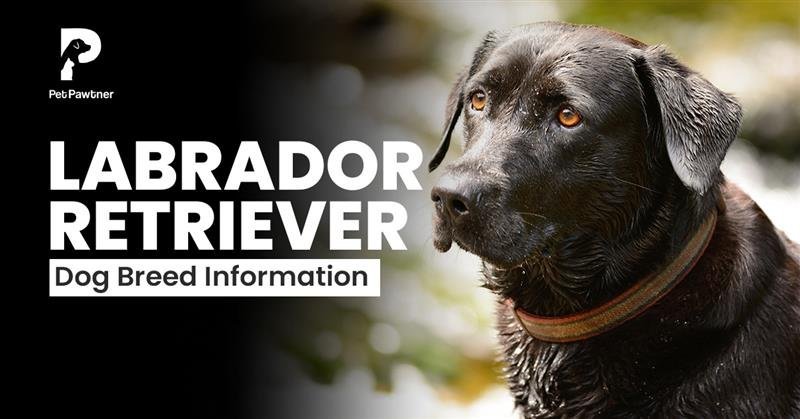


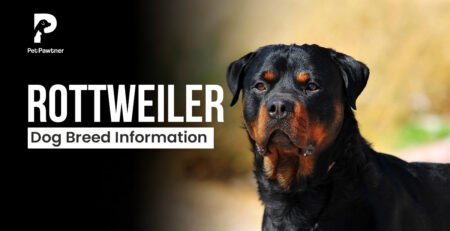



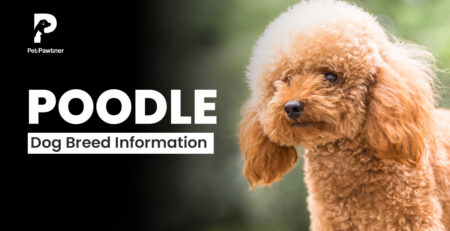


Comments (2)
[…] Labrador Retrievers (commonly known as Labradors) are kind, cute, and easy to love. They are one of the most popular dog breeds in Pakistan. Labradors are fun loving, friendly, and full of love for everyone in the family. read more […]
[…] For more details about Labradors […]